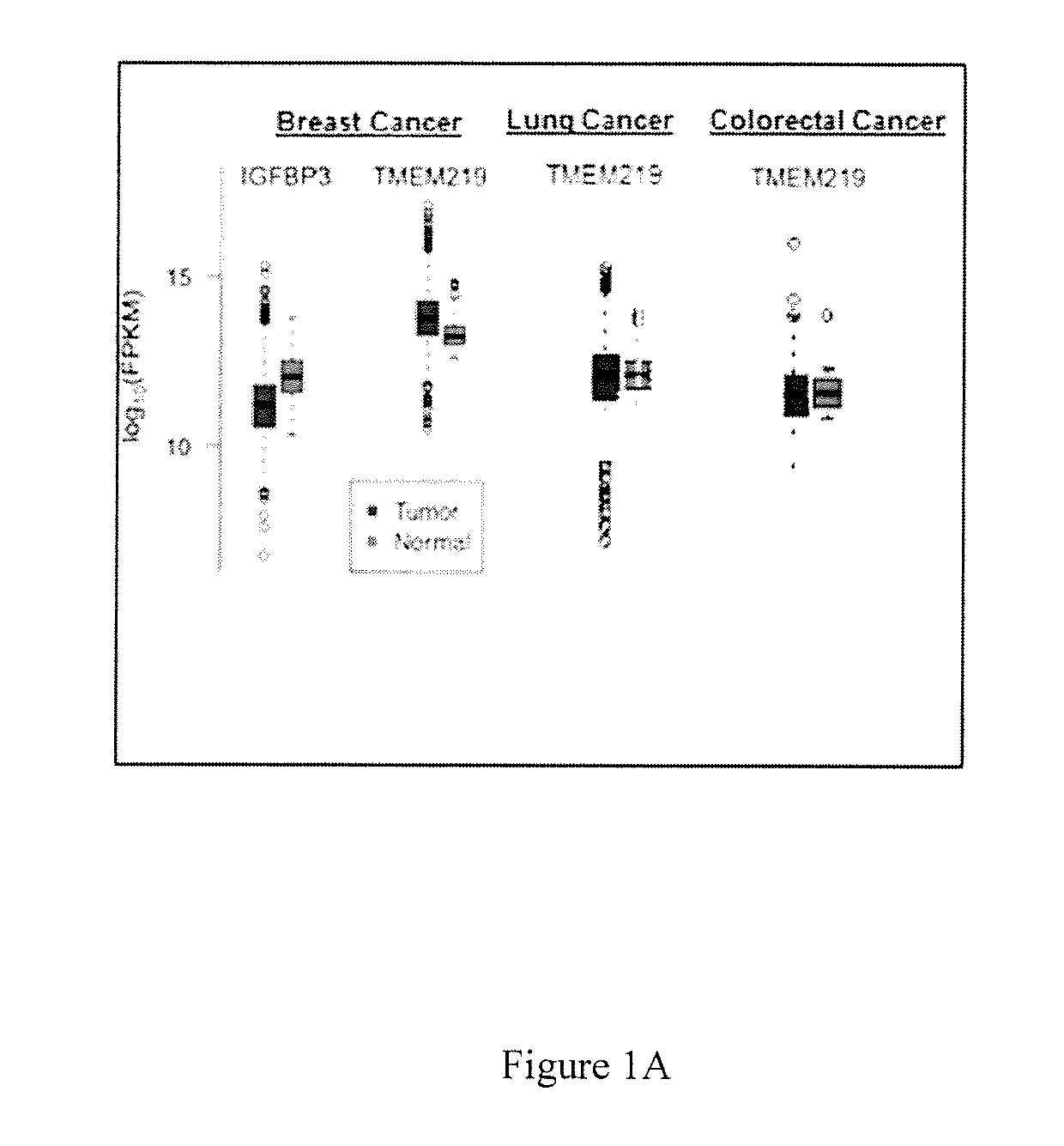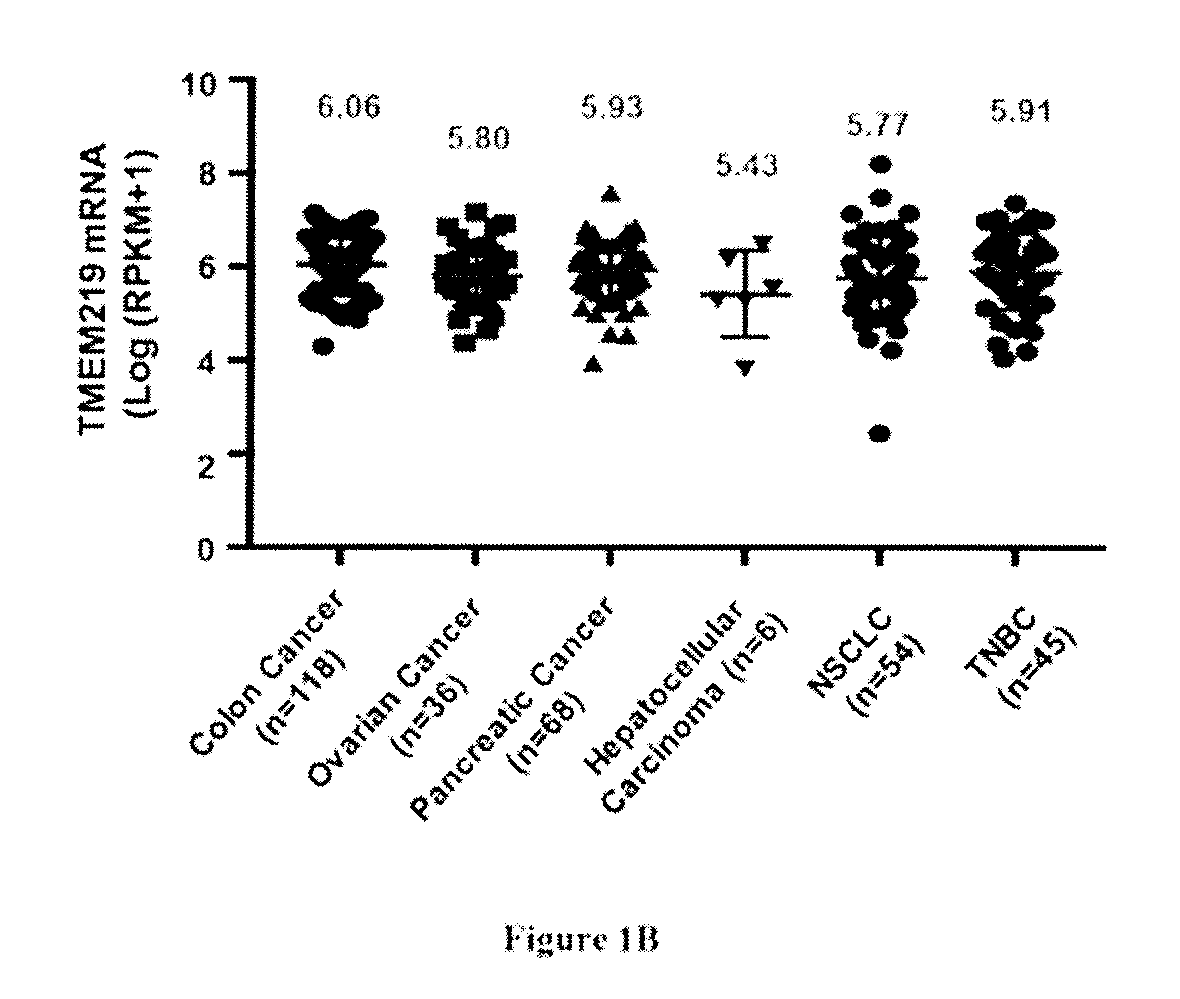Treatment of diseases related to igfb3 and its receptor
a technology of igfb3 and receptor, which is applied in the field of treating diseases involving igfb3 and its receptor, can solve the problems of poor prognosis, increased risk of metastasis, recurrence and/or recurrence, and low expression level of tmem219 in tumor cells, so as to improve the overall survival chance, improve the prognosis, and improve the survival ra
- Summary
- Abstract
- Description
- Claims
- Application Information
AI Technical Summary
Benefits of technology
Problems solved by technology
Method used
Image
Examples
example 1
cs: TMEM219 as a Molecular Marker for Predicting Recurrence and Survival in Cancer
[0087]Bioinformatics analysis of The Cancer Genome Atlas (TCGA) data showed that IGFBP-3 is significantly lower in breast cancer, whereas expression of TMEM219 is similar or higher in breast, colon and lung cancers compared to normal tissues. This finding shows that the antitumor IGFBP-3 / TMEM219 axis is impaired during tumorigensis / progression of cancer due to suppressed expression of IGFBP-3 but not its receptor TMEM219 (FIG. 1). Further assessment using data from the METABRIC study (Curtis et al., Nature. 2012:486(7403):346-52) and the SynTarget tool [Pub Med PMID: 26915292] showed that TMEM219 expression is strongly correlated with survival of breast cancer (Table 1).
TABLE 1Assessment of Correlation of TMEM219 with Survivalof Breast Cancer Patients using the SynTarget toolCancer SubtypeGene IDSurvival(Clinical Variable)(Probe ID)Effectp-valueAll samplesTMEM219Pos5.32e−07(ILMN_1737644)Histological_ty...
example 2
ntibodies and Cancer
[0090]The naturally occurring TMEM219 agonist does not in and of itself represent a useful therapeutic agent due to significant post-translational modification: proteolysis induced by tumor activated proteases attenuates TMEM219 antitumor signaling. Thus, monoclonal antibodies (mAbs) that activate TMEM219, i.e. “agonist antibodies” were created. The process of manufacturing mAbs has been standardized in the art and mAbs are known to exhibit robust stability within the body, without inducing major deleterious side effects. The “agonist mAb” approach advantageously precludes the need to use toxic compounds to kill the cancer cells.
[0091]A panel of TMEM219 specific monoclonal antibodies was generated and two exemplary antibodies were sequenced (#245 and #274, FIGS. 5A and B). Further, a TMEM219 #274-human IgG1 chimera which acts like the TMEM219 natural agonist was also developed (FIG. 5C). As shown in FIG. 6A-C, treatment with one of the hybridoma cell-produced TME...
example 3
[0100]According to World Health Organization estimates, overweight and obesity now overshadow underweight and malnutrition as significant causes of premature death. Nearly two-thirds of adults in the United States are overweight or obese, and obesity is a major risk factor for a myriad of serious comorbidities including hypertension, type 2 diabetes mellitus (T2DM), cardiovascular disease (CVD), and other metabolic disorders. Additionally, rapidly increasing rates of obesity in children and young adults has been observed and is resulting in immediate and lifelong metabolic disease risk. Lifestyle changes to counteract obesity and physical inactivity have been emphasized as the first line of defense against progression to T2DM, however there has been no significant decrease in the incidence of obesity. More effective preventive and therapeutic strategies are needed to thwart obesity and associated metabolic complications.
[0101]Insulin resistance (IR) represents a common metabolic der...
PUM
| Property | Measurement | Unit |
|---|---|---|
| tumor shrinkage | aaaaa | aaaaa |
| tumor shrinkage | aaaaa | aaaaa |
| tumor shrinkage | aaaaa | aaaaa |
Abstract
Description
Claims
Application Information
 Login to View More
Login to View More - R&D
- Intellectual Property
- Life Sciences
- Materials
- Tech Scout
- Unparalleled Data Quality
- Higher Quality Content
- 60% Fewer Hallucinations
Browse by: Latest US Patents, China's latest patents, Technical Efficacy Thesaurus, Application Domain, Technology Topic, Popular Technical Reports.
© 2025 PatSnap. All rights reserved.Legal|Privacy policy|Modern Slavery Act Transparency Statement|Sitemap|About US| Contact US: help@patsnap.com



